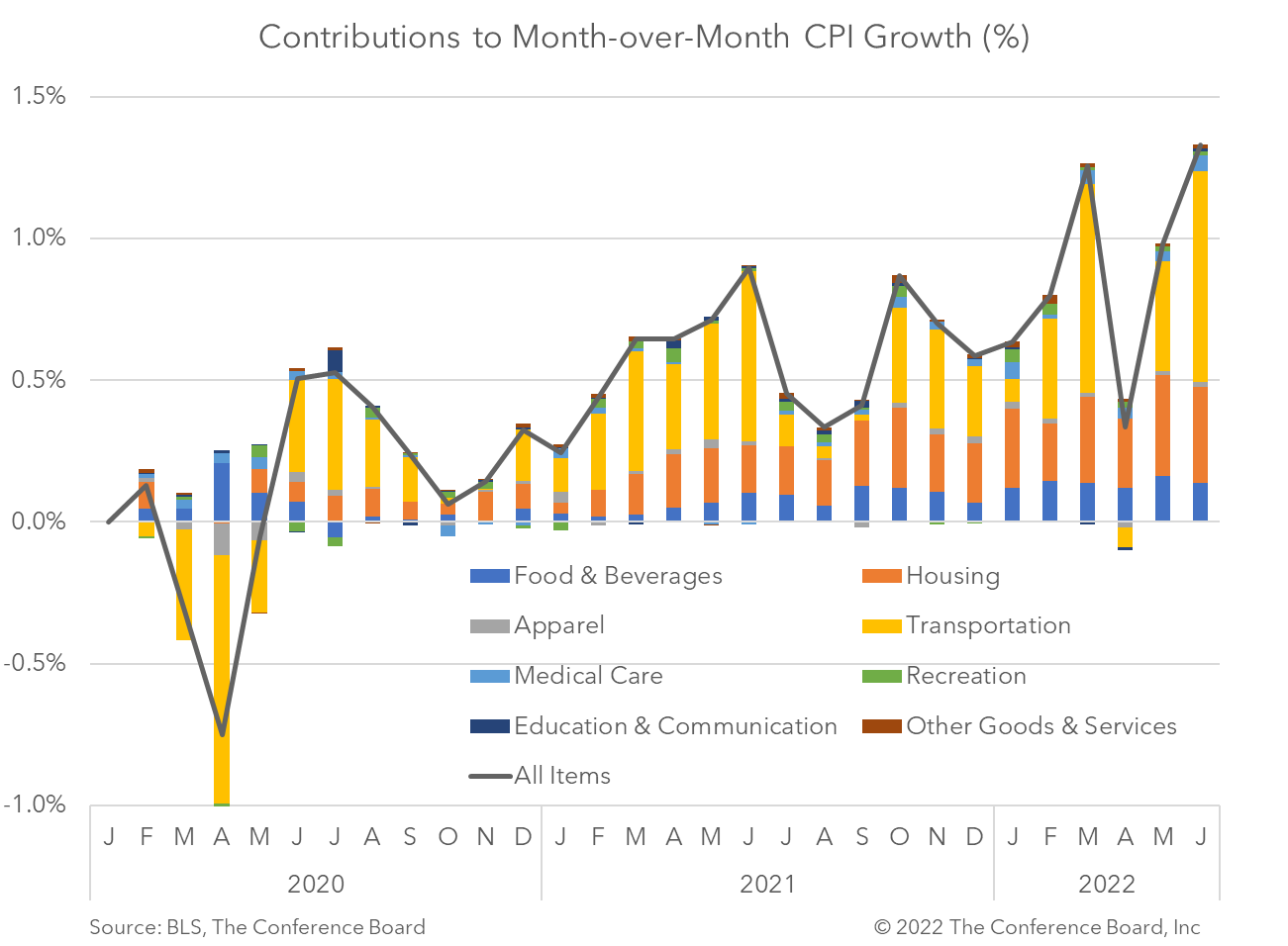CPI Reaction—Prices Hit Another 41-year High
13 Jul. 2022 | Comments (0)
The total Consumer Price Index (CPI) rose 9.1 percent year-over-year in June, another 41-year high. Prices increased both month-over-month and relative to a year ago, providing further reason for the Fed to follow through with a 75bp rate hike on July 27th. Core CPI inflation slowed year-over-year for a third consecutive month, but remains extremely elevated. Although prices for select durables are falling, the war in Ukraine continues to stoke nondurables prices, particularly for food and energy (i.e., gasoline and energy utilities). Additionally, shelter prices are picking up pace - the rent index rose 0.8 percent over the month, the largest monthly increase since April 1986. These shelter costs represent roughly one-third of consumers’ total basket of goods and services consumed.
Insights for What’s Ahead
- High inflation will continue to constrain consumers’ purchasing power in the near term. Today’s data are consistent with our expectation that overall consumer prices would continue to rise through 2Q 2022. We project that after reaching a peak in 2Q, year-over-year inflation will slow. Indeed, progress made in oil in gasoline prices in recent weeks should help the July CPI reading come down. Core (total less food and energy) inflation did slow year-over-year in June compared to May, but remains extremely elevated.
- Given the current inflation environment, we continue to anticipate that the Fed will hike 75bp in July and will raise the federal funds rate to 3.375 percent by the end of the year and then up to 3.875 in early 2023 – deep into “restrictive” territory. Even with this degree of monetary policy tightening, key consumer price indexes, specifically the personal consumption and expenditure deflator, may remain notably above the 2 percent target (we forecast 2.7 year-on-year) by the end of 2023.
- Borrowing costs will remain elevated in the near term. In its fight against inflation we expect the Fed to raise the federal funds rate to 3.875 in early 2023. Doing so will likely trigger a US recession. Anemic growth and elevated inflation before and after this recession will exhibit stagflationary characteristics.
June Inflation Highlights
Total CPI continued to rise in June. The gauge rose by 1.3 percent month-over-month in June, following a 1.0 percent increase in May. On a year-on-year basis, headline inflation hastened to 9.1 percent – the fastest pace since November 1981 – from 8.5 percent. The increase was broad-based, with the indexes for gasoline, shelter, and food being the largest contributors. The energy index rose 7.5 percent over the month and contributed nearly half of the all items increase, with the gasoline index rising 11.2 percent and the other major component indexes also rising. The food index rose 1.0 percent in June, as did the food at home index.
Core CPI also rose for the month, but this marks the third consecutive month of slower annual gains. The core index, which is total CPI less volatile food and energy prices, rose by 0.7 percent month-over-month in June, vs. 0.6 percent the month prior. However, the rate of inflation was 5.9 percent higher compared to a year ago in June compared to 6.0 percent in May. The relative improvement reflects smaller increases in good prices compared to a year ago, especially new and used vehicles.
Rents kept Core CPI high in June. The shelter index increased 0.6 percent in June, as it did in May. Indeed, the rent index rose 0.8 percent over the month, the largest monthly increase since April 1986, and the owners' equivalent rent index rose 0.7 percent. On a year-over-year basis, the shelter index rose 5.6 percent over the last year, the largest 12-month increase since the period ending February 1991.

-
About the Author:Erik Lundh
Erik Lundh is Senior Global Economist for The Conference Board Economy, Strategy & Finance Center, where he focuses on monitoring global economic developments and overseeing the organization&rsquo…




0 Comment Comment Policy